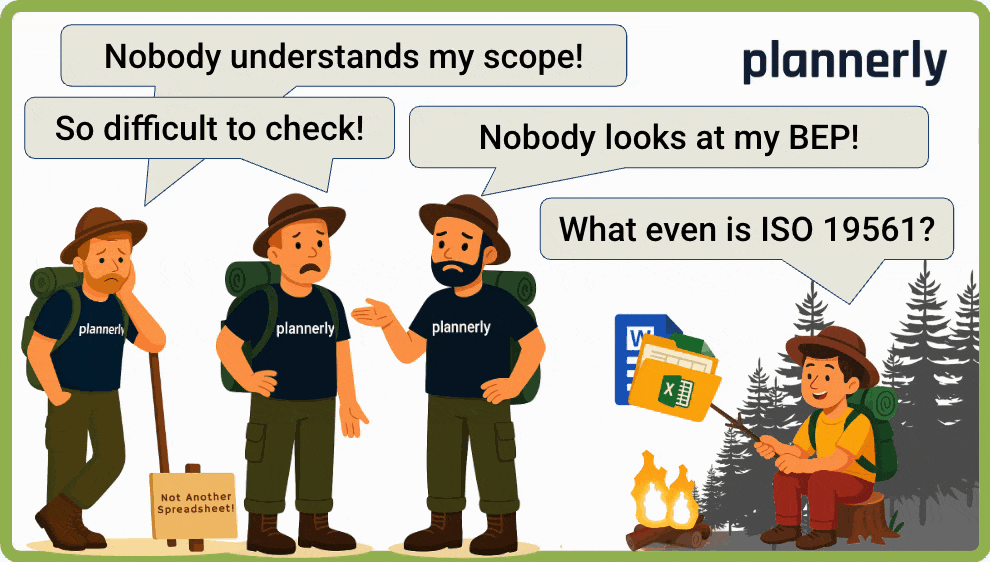
Part 1 of the BIM Training Camp Series
If you’ve ever poured your heart into a BIM Execution Plan (BEP) only to watch it vanish into the project’s black hole of forgotten documents… you’re not alone.
Somewhere out there is a landfill filled with orphaned BEPs… next to the unclaimed Tupperware lids and those mystery Allen keys.
Our own project experience shows these challenges are all too familiar:
- Nobody looks at the BEP – because it’s often just a Word document or PDF, copied and pasted from past projects, not collaborative, and circulated like a formality rather than a living document.
- Nobody understands the scope – because it lives in an Excel file so crammed with rows, columns, abbreviations, and hidden rules that only its creator can truly make sense of it.
- It’s difficult to check – because the plan and scope are disconnected from the workflow, making accountability nearly impossible.
- Standards confusion – teams often struggle to interpret, train on, follow, and make the best use of the standards available. Cue the slightly tongue-in-cheek complaint: “What even is ISO-19561?” (Yes, we know it’s really ISO-19650.)
The First Part: BEPs Become Wallpaper
The first part of the challenge is the BIM execution plan itself.
Too often it’s:
- Written in Word,
- Copy-pasted from the last project,
- Circulated as a PDF in an email blast… and then forgotten.
And once that PDF gets beyond 30 pages (sometimes stretching to hundreds), the odds of it being read drop faster than a contractor’s phone battery on site.
The Second Part: Spreadsheet Spaghetti
The trouble doesn’t stop with the BEP.
It’s usually accompanied by a responsibility matrix – the spreadsheet where all the tasks live, sometimes with Levels of Development (LODs) or Levels of Information Need.
That’s where things start to get… sticky:
- The spreadsheet grows so complex that only its original author can truly unpack and use it.
- It’s often not connected to the workflow – sitting in isolation instead of driving project activity.
- Teams sometimes end up with multiple responsibility matrices, each with their own tabs, abbreviations, and quirks.
Soon you’re staring at hundreds or thousands of rows and columns across several files.
And that’s when the real spreadsheet spaghetti sets in.
The Third Part: Standards Challenge
Even with a solid BEP and a tidy responsibility matrix, many teams still hit a wall when it comes to standards.
International frameworks like ISO 19650 provide a powerful foundation for collaboration and consistency – but only if everyone actually understands them.
Too often:
- The language feels overly technical or abstract.
- Training is inconsistent or missing entirely.
- Teams aren’t sure how to translate theory into practical workflows.
The result? Confusion, inconsistency, and missed opportunities to align with best practice – all summed up in that campfire quip: “What even is ISO-19561?”
The Root Cause: A Perfect Storm of Project Pain
It’s tempting to point the finger at one single problem – but the reality is that these issues usually pile up and feed off each other.
Here are the usual suspects we see again and again:
- Disconnected tools – your BEP in one place, scope in another, model checks somewhere else entirely.
- Many conflicting standards – trying to follow multiple frameworks that don’t quite align, leading to confusion.
- Inconsistent project setup – no agreed starting point, so every project feels like reinventing the wheel.
- Spreadsheet spaghetti – responsibility matrices that are so complex they deserve their own Michelin star rating.
- Unclear responsibilities – nobody’s sure who’s actually accountable for what.
- Missing project goals – starting work without clearly defined success criteria.
Put together, this creates the perfect recipe for frustration, delays, and costly rework.
Or as we used to joke back in our industry days: “Welcome to the No Accountability Club”
The Fix: Make It Structured (and Human-Friendly)
Instead of burying critical project processes in PDFs, spreadsheets, and static standards documents:
- Keep requirements clear, connected, and visible to the right people at the right time
- Use tools that integrate your BEP, responsibility matrix, and standards with your Common Data Environment (CDE) and model verification workflows – in the most simple way possible!
- Make updates easy – because nobody loves “Version 9_final_FINAL_reallythisone.xlsx”
Structured BIM project planning isn’t about making more documents. It’s about making the right information accessible and actionable – and standards part of the workflow, not a side note.
Watch the Session 🎥
This blog is part of our BIM Summer Camp educational series.
Grab a coffee and watch Episode 1 – Why Nobody Reads Your BEP (and How to Fix It) – to see the demos, examples, and practical steps we covered:
Key Takeaway
Your BIM Execution Plan should be more than a compliance tick-box.
Make it clear.
Make it connected.
Make it easy to follow
…and maybe, just maybe, people will read it 😉
Your Next Step in BIM
Better Information Management is about how you build clarity, drive accountability, and earn trust.
Three quick paths to better BIM outcomes:


